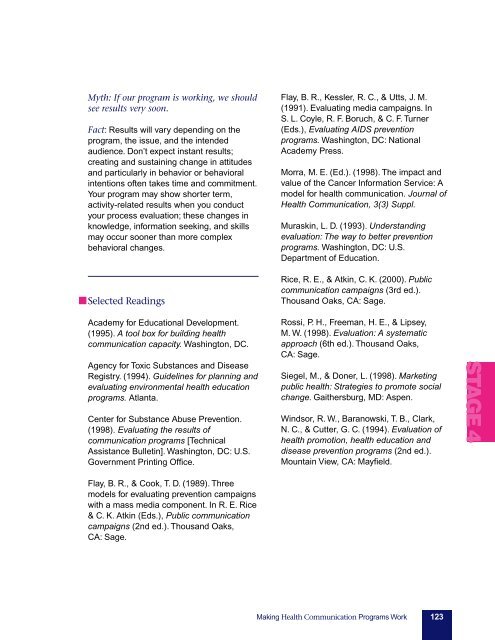pink-book
pink-book
pink-book
Create successful ePaper yourself
Turn your PDF publications into a flip-book with our unique Google optimized e-Paper software.
Myth: If our program is working, we should<br />
see results very soon.<br />
Fact: Results will vary depending on the<br />
program, the issue, and the intended<br />
audience. Don’t expect instant results;<br />
creating and sustaining change in attitudes<br />
and particularly in behavior or behavioral<br />
intentions often takes time and commitment.<br />
Your program may show shorter term,<br />
activity-related results when you conduct<br />
your process evaluation; these changes in<br />
knowledge, information seeking, and skills<br />
may occur sooner than more complex<br />
behavioral changes.<br />
Selected Readings<br />
Academy for Educational Development.<br />
(1995). A tool box for building health<br />
communication capacity. Washington, DC.<br />
Agency for Toxic Substances and Disease<br />
Registry. (1994). Guidelines for planning and<br />
evaluating environmental health education<br />
programs. Atlanta.<br />
Center for Substance Abuse Prevention.<br />
(1998). Evaluating the results of<br />
communication programs [Technical<br />
Assistance Bulletin]. Washington, DC: U.S.<br />
Government Printing Office.<br />
Flay, B. R., & Cook, T. D. (1989). Three<br />
models for evaluating prevention campaigns<br />
with a mass media component. In R. E. Rice<br />
& C. K. Atkin (Eds.), Public communication<br />
campaigns (2nd ed.). Thousand Oaks,<br />
CA: Sage.<br />
Flay, B. R., Kessler, R. C., & Utts, J. M.<br />
(1991). Evaluating media campaigns. In<br />
S. L. Coyle, R. F. Boruch, & C. F. Turner<br />
(Eds.), Evaluating AIDS prevention<br />
programs. Washington, DC: National<br />
Academy Press.<br />
Morra, M. E. (Ed.). (1998). The impact and<br />
value of the Cancer Information Service: A<br />
model for health communication. Journal of<br />
Health Communication, 3(3) Suppl.<br />
Muraskin, L. D. (1993). Understanding<br />
evaluation: The way to better prevention<br />
programs. Washington, DC: U.S.<br />
Department of Education.<br />
Rice, R. E., & Atkin, C. K. (2000). Public<br />
communication campaigns (3rd ed.).<br />
Thousand Oaks, CA: Sage.<br />
Rossi, P. H., Freeman, H. E., & Lipsey,<br />
M. W. (1998). Evaluation: A systematic<br />
approach (6th ed.). Thousand Oaks,<br />
CA: Sage.<br />
Siegel, M., & Doner, L. (1998). Marketing<br />
public health: Strategies to promote social<br />
change. Gaithersburg, MD: Aspen.<br />
Windsor, R. W., Baranowski, T. B., Clark,<br />
N. C., & Cutter, G. C. (1994). Evaluation of<br />
health promotion, health education and<br />
disease prevention programs (2nd ed.).<br />
Mountain View, CA: Mayfield.<br />
STAGE 4<br />
Making Health Communication Programs Work 123


